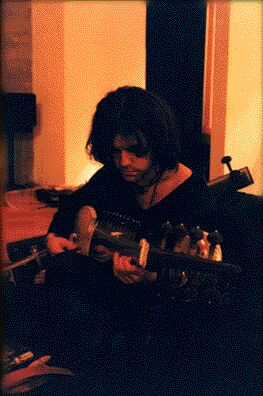

The Sarod originated from the Arabic instrument, the rebab and around 1300 AD was
named the Sah-roda; a bowed, gut instrument introduced to the Mughal court of North India. Modifications and changes to the Sarod continued until the end of the nineteenth
century since when it has remained constant; wire strings plucked with a coconut or ivory
plectrum. The body of the Sarod is carved from one piece of teak or mahogany wood and
is approximately 1.2m in length varying slightly when custom made for a
India. Modifications and changes to the Sarod continued until the end of the nineteenth
century since when it has remained constant; wire strings plucked with a coconut or ivory
plectrum. The body of the Sarod is carved from one piece of teak or mahogany wood and
is approximately 1.2m in length varying slightly when custom made for a specific
performer. The bridge is supported on a soundboard of stretched leather, which is
extremely sensitive to vibration and temperature change. The fingerboard is metal andfretless and the full resonance of the note is produced by pressing the string onto the
fingerboard using the fingernails of the left hand. Not having frets allows for both precise
specific
performer. The bridge is supported on a soundboard of stretched leather, which is
extremely sensitive to vibration and temperature change. The fingerboard is metal andfretless and the full resonance of the note is produced by pressing the string onto the
fingerboard using the fingernails of the left hand. Not having frets allows for both precise individual notes and a variety of intonations through glissando. Of the 25 strings, 4 are
used for melody, 2 for rhythm, 4 tuned to the dominant note
individual notes and a variety of intonations through glissando. Of the 25 strings, 4 are
used for melody, 2 for rhythm, 4 tuned to the dominant note of the raga and the
remaining 15 are sympathetic vibrating strings tuned to the micro notes of the raga. The
range and sonority of the Sarod makes it one of the most beautiful of North Indian
instruments, its complexity allowing for an extraordinary diversity of sound and mood.
of the raga and the
remaining 15 are sympathetic vibrating strings tuned to the micro notes of the raga. The
range and sonority of the Sarod makes it one of the most beautiful of North Indian
instruments, its complexity allowing for an extraordinary diversity of sound and mood.
Jeff Martin plays the sarod during Inanna live as well as The Badger and Sister Awake from the Edges of Twililight

